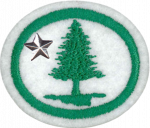Difference between revisions of "AY Honors/Trees - Advanced/Answer Key/es"
From Pathfinder Wiki
< AY Honors | Trees - AdvancedAY Honors/Trees - Advanced/Answer Key/es
(Created page with "<!-- b. ¿Qué indican las dos partes de un nombre científico? -->") |
(Created page with "</noinclude> <!-- 5. Mencionar seis familias de árboles en la clase angiospermas y tres familias en la clase gimnospermas. -->") |
||
| Line 89: | Line 89: | ||
{{ansreq|page={{#titleparts:{{PAGENAME}}|2|1}}|num=5}} | {{ansreq|page={{#titleparts:{{PAGENAME}}|2|1}}|num=5}} | ||
<noinclude></noinclude> | <noinclude></noinclude> | ||
| − | <!-- 5. | + | <!-- 5. Mencionar seis familias de árboles en la clase angiospermas y tres familias en la clase gimnospermas. --> |
| − | |||
| − | |||
| − | |||
| − | |||
| − | |||
| − | |||
| − | |||
| − | |||
| − | |||
| − | |||
| − | |||
| − | |||
| − | |||
| − | |||
| − | |||
| − | |||
| − | |||
{{clear}} | {{clear}} | ||
Revision as of 03:42, 1 March 2021
| Árboles- Avanzado | ||
|---|---|---|
| Asociación General
|
Destreza: 3 Año de introducción: 1949 |
|
Requisitos
1
Tener la especialidad de Árboles.
Para consejos e instrucciones, véase Árboles.
2
Recolectar, identificar, prensar y montar hojas de 35 diferentes especies de árboles.
3
Recolectar por separado, prensar, montar y etiquetar especímenes que demuestran los siguientes términos:
3a
Aserrado
3b
Doble aserrado
3c
Entera
3d
Crenado
3e
Dentado
3f
Lobulada
3g
Inciso
3h
Verticiladas
3i
Opuestas
3j
Alternas
3k
Pinnatisecta compuesta
3l
Triple compuesta (si es posible)
4
Hacer lo siguiente:
5
Mencionar seis familias de árboles en la clase angiospermas y tres familias en la clase gimnospermas.
6
Conocer y describir la función de las hojas en la vida de un árbol.
A leaf is the part of a plant specialized for photosynthesis. For this purpose, a leaf is typically flat and thin, to expose the cells containing chloroplast to light over a broad area, and to allow light to penetrate fully into the tissues. Leaves can store food and water.
7
Mencionar las familias de árboles en su área que tienen hojas opuestas.
This is a partial list of trees with opposite leaves. There may be more in your area.
8
Definir los siguientes términos:
8a
Estípula
8b
Pecíolo
8c
Brizna
8d
Pino
8e
Duramen
Examination of the cross-section of a log will reveal dark wood near the center, and light-colored wood near the bark. The dark wood near the center is heartwood. As a tree increases in age and diameter an inner portion of the sapwood becomes inactive and finally ceases to function, as the cells die. This inert or dead portion is called heartwood.
8f
Albura
8g
Anillo de primavera
8h
Anillo de verano
8i
Anillo anual
8j
Cámbium
8k
Xilema
8l
Floema
9
¿Qué familias de árboles tiene:
9a
espinas?
9b
amento?
9c
semillas aladas?
9d
bellotas?
9e
las vainas?
9f
cápzulas?
9g
nueces?
9h
bayas?
10
Identificar 10 árboles de hoja caduca por sus características de «invierno» (características que no sean las hojas) como ramas y el capullo, forma características y hábitos de crecimiento.
By bark
The bark of many trees is easily recognizable, and in some cases, using the bark to identify the tree is easier than using the leaves.
Referencias
Categories:
- Categoría: Tiene imagen de insignia
- Adventist Youth Honors Answer Book/Honors/es
- Adventist Youth Honors Answer Book/es
- Adventist Youth Honors Answer Book/Skill Level 3/es
- Categoría: Libro de respuestas de especialidades JA/Especialidades introducidas en 1949
- Adventist Youth Honors Answer Book/General Conference/es
- Adventist Youth Honors Answer Book/Nature/es
- Adventist Youth Honors Answer Book/Nature/Primary/es
- Adventist Youth Honors Answer Book/Stage 0/es
- AY Honors/Prerequisite/Trees/es
- AY Honors/See Also/Trees/es

